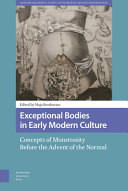
Exceptional Bodies in Early Modern Culture : Concepts of Monstrosity Before the Advent of the Normal PDF
204 Pages·2020·2.8577 MB·other
Most books are stored in the elastic cloud where traffic is expensive. For this reason, we have a limit on daily download.
Preview Exceptional Bodies in Early Modern Culture : Concepts of Monstrosity Before the Advent of the Normal
Description:
Drawing on a rich array of textual and visual primary sources-including medicine, satire, play script, dictionaries, natural philosophy, and texts on collecting wonders-this book provides a fresh perspective on monstrosity in early modern European culture. The essays explore how exceptional bodies challenged social, religious, sexual and natural structures and hierarchies in the sixteenth-, seventeenth- and early eighteenth centuries and contributed to its knowledge, virtue and emotional repertoire. Prodigious births, maternal imagination, hermaphrodites, collections of extraordinary things, powerful women, disabilities, controversial exercise, shapeshifting phenomena, and hybrids of different kinds are examined in a period before all deviances became normalized, in the sense, close and relative to a homogenous standard. The historicizing of exceptional bodies is central in the volume since it brings out the early modern culture and deepen our knowledge of its specific ways of conceptualizing singularities, rare examples, paradoxes, rules and conventions in nature and society.
See more
The list of books you might like
Most books are stored in the elastic cloud where traffic is expensive. For this reason, we have a limit on daily download.
